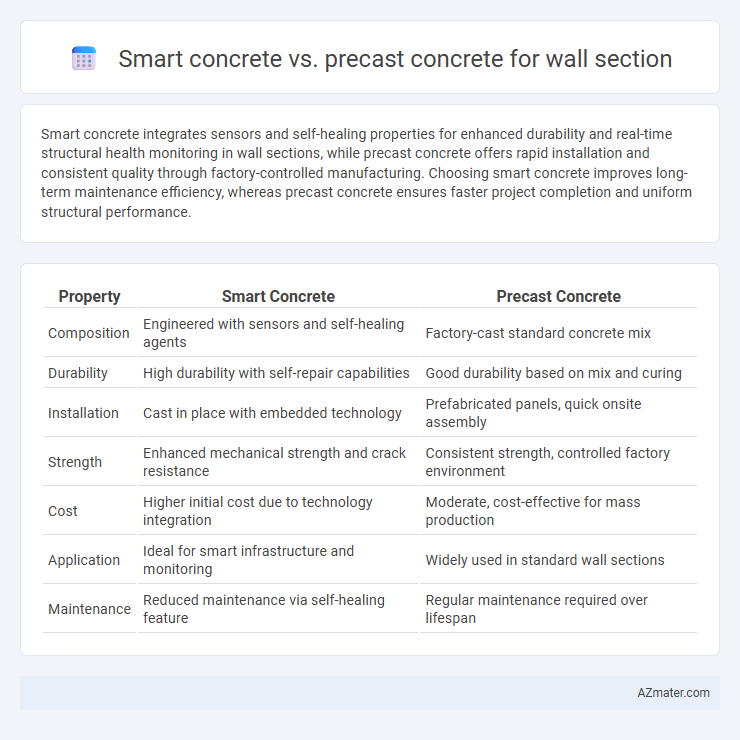Smart concrete integrates sensors and self-healing properties for enhanced durability and real-time structural health monitoring in wall sections, while precast concrete offers rapid installation and consistent quality through factory-controlled manufacturing. Choosing smart concrete improves long-term maintenance efficiency, whereas precast concrete ensures faster project completion and uniform structural performance.
Table of Comparison
| Property | Smart Concrete | Precast Concrete |
|---|---|---|
| Composition | Engineered with sensors and self-healing agents | Factory-cast standard concrete mix |
| Durability | High durability with self-repair capabilities | Good durability based on mix and curing |
| Installation | Cast in place with embedded technology | Prefabricated panels, quick onsite assembly |
| Strength | Enhanced mechanical strength and crack resistance | Consistent strength, controlled factory environment |
| Cost | Higher initial cost due to technology integration | Moderate, cost-effective for mass production |
| Application | Ideal for smart infrastructure and monitoring | Widely used in standard wall sections |
| Maintenance | Reduced maintenance via self-healing feature | Regular maintenance required over lifespan |
Introduction to Modern Concrete Solutions for Walls
Smart concrete integrates advanced technologies such as embedded sensors and self-healing properties to enhance durability and real-time structural health monitoring in wall sections. Precast concrete offers precision manufacturing in controlled environments, ensuring uniform quality, faster installation, and reduced on-site labor for wall construction. Both solutions address modern construction demands, with smart concrete optimizing functionality and precast concrete emphasizing efficiency and consistency.
What is Smart Concrete?
Smart concrete, embedded with sensors and advanced materials, enables real-time monitoring of structural health by detecting stress, cracks, temperature changes, and corrosion in wall sections. Unlike precast concrete, which is manufactured off-site and transported for installation, smart concrete incorporates self-healing properties and responsive technologies that enhance durability and safety. This innovative material optimizes maintenance and extends the lifespan of concrete walls through continuous data collection and adaptive performance.
Understanding Precast Concrete for Wall Sections
Precast concrete for wall sections offers enhanced durability, precision, and faster installation compared to traditional casting methods, making it a preferred choice in modern construction. This method involves casting concrete elements in a controlled factory environment, ensuring consistent quality, improved structural integrity, and reduced on-site labor costs. Its modular nature allows for easy customization and better thermal insulation, contributing to energy-efficient building designs.
Strength and Durability Comparison
Smart concrete incorporates advanced additives like nanomaterials and self-healing agents, significantly enhancing its compressive strength and crack resistance compared to traditional precast concrete. Precast concrete offers consistent quality and controlled curing conditions, resulting in reliable strength; however, it may lack the adaptive durability features found in smart concrete formulations. The superior durability of smart concrete ensures prolonged lifespan and reduced maintenance in wall sections, outperforming conventional precast concrete under aggressive environmental conditions.
Installation and Construction Speed
Smart concrete incorporates advanced self-sensing and self-healing properties, significantly reducing installation time by minimizing the need for extensive post-placement monitoring and repairs. Precast concrete wall sections enable rapid on-site construction through factory-controlled manufacturing and quick assembly, accelerating project timelines but require precise logistics and crane operations. Both materials enhance construction speed, with smart concrete optimizing in-situ efficiency and precast concrete maximizing prefabrication advantages.
Energy Efficiency and Sustainability
Smart concrete integrates sensors that monitor structural health and optimize energy consumption through adaptive thermal regulation, enhancing wall section energy efficiency. Precast concrete offers sustainability benefits by reducing construction waste and enabling rapid installation with consistent thermal performance due to factory-controlled production. Both materials support eco-friendly building practices, but smart concrete's dynamic response capabilities provide superior long-term energy savings in wall applications.
Cost Analysis: Smart Concrete vs Precast Concrete
Smart concrete incorporates advanced sensors and materials that can increase initial costs but reduce long-term expenses through durability and maintenance savings. Precast concrete offers lower upfront costs due to mass production efficiency but may incur higher transportation and installation expenses. Analyzing total lifecycle costs, smart concrete tends to be more cost-effective in projects prioritizing structural health monitoring and longevity.
Design Flexibility and Aesthetics
Smart concrete offers enhanced design flexibility with its ability to incorporate sensors and self-healing properties, allowing for innovative wall designs that adapt to environmental changes over time. Precast concrete provides consistent aesthetics with precise manufacturing processes, enabling uniform textures and finishes but limiting customization once cast. For applications prioritizing dynamic functionality and unique architectural expressions, smart concrete outperforms precast in blending advanced technology with design innovation.
Maintenance and Longevity Considerations
Smart concrete incorporates embedded sensors that enable real-time structural health monitoring, reducing long-term maintenance costs by detecting cracks and stress early. Precast concrete offers high durability and consistent quality due to factory-controlled production, which minimizes defects and extends wall longevity. Both materials enhance lifespan, but smart concrete's adaptive monitoring provides proactive maintenance advantages over traditional precast options.
Choosing the Best Solution for Your Wall Section Needs
Smart concrete incorporates advanced materials like self-healing polymers and sensors that enhance durability and monitor structural health, making it ideal for high-performance wall sections requiring longevity and real-time maintenance data. Precast concrete offers consistent quality, faster installation, and allows for complex architectural designs, providing cost-effective solutions suitable for large-scale projects with repetitive wall panels. Evaluating factors such as environmental conditions, budget constraints, and desired performance metrics will guide the selection between smart and precast concrete for optimizing wall section efficiency and lifespan.

Infographic: Smart concrete vs Precast concrete for Wall section
 azmater.com
azmater.com